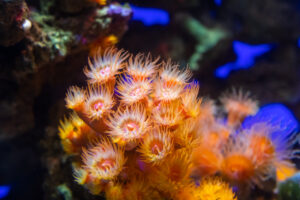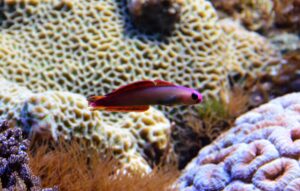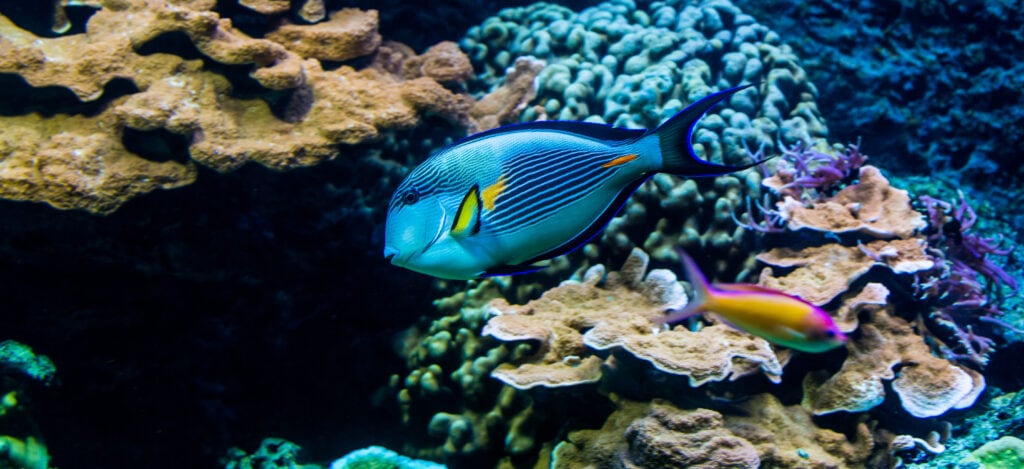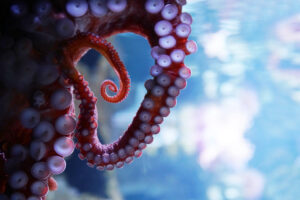Proper stocking procedure can have a huge long-term impact on the health of your aquarium system. That’s why proper order of stocking is so important. For example, after certain groups of beneficial microbes (as described in the last article of this series), copepods are among the first organisms to stock. These tiny crustaceans are an essential part of reef foods chains. In aquaria, the adults of benthic species are invaluable herbivores and detritivores; their pelagic larvae are a nutritious food source for zooplanktivorous filter-feeders. A refugium full of fast-growing fleshy algae such as Gracilaria promotes large and stable copepod populations.
Order order
 Before proceeding, it is best to allow the reef base to mature such that there is clear recovery and growth of filter-feeders. This can take as long as a month or so. Lights over the main tank should remain off (however, if in use, planted refugia should be brightly illuminated). Depending upon the types of filter-feeders present, it might be a good idea to begin offering modest feedings of phytoplankton or some other suitable liquid invertebrate diet; this can accelerate the growth of both live rock organisms and copepods.
Before proceeding, it is best to allow the reef base to mature such that there is clear recovery and growth of filter-feeders. This can take as long as a month or so. Lights over the main tank should remain off (however, if in use, planted refugia should be brightly illuminated). Depending upon the types of filter-feeders present, it might be a good idea to begin offering modest feedings of phytoplankton or some other suitable liquid invertebrate diet; this can accelerate the growth of both live rock organisms and copepods.
Topping the ecological pyramid
Trophic: From the top
 Where there is a well-developed trophic community of microbes, filter-feeders and detritivores in the sand bed and on the live rock, excretory wastes are cycled quite effectively. But there are limits to the rate at which these inputs can be processed. Once these limits are breached, concentrations of dissolved nutrients and organic compounds will rise rapidly. Water changes and chemical filtration will consequently be required to prevent problems such as algal blooms, low pH, and so on. That is, excesses of these substances must somehow be ‘exported‘ from the system.
Where there is a well-developed trophic community of microbes, filter-feeders and detritivores in the sand bed and on the live rock, excretory wastes are cycled quite effectively. But there are limits to the rate at which these inputs can be processed. Once these limits are breached, concentrations of dissolved nutrients and organic compounds will rise rapidly. Water changes and chemical filtration will consequently be required to prevent problems such as algal blooms, low pH, and so on. That is, excesses of these substances must somehow be ‘exported‘ from the system.





Shari Robinson says
I really enjoyed part 4 of this article, but where can I find parts 1-3? My current tank is 18 months old, and I’ve made lots of mistakes, but it’s coming along. I am awaiting the arrival of my new tank and want to make every effort in starting it the best way for success. This method speaks to me, and I’m hoping to follow it.
Thank you
greg.chernoff says
Hello Shari! Here are the other pieces of the article for you
https://www.algaebarn.com/blog/advanced/trophic-structure-in-the-reef-aquarium-part-1/
https://www.algaebarn.com/blog/other/trophic-structure-in-the-reef-aquarium-part-2/
https://www.algaebarn.com/blog/advanced/trophic-structure-in-the-reef-aquarium-part-3/